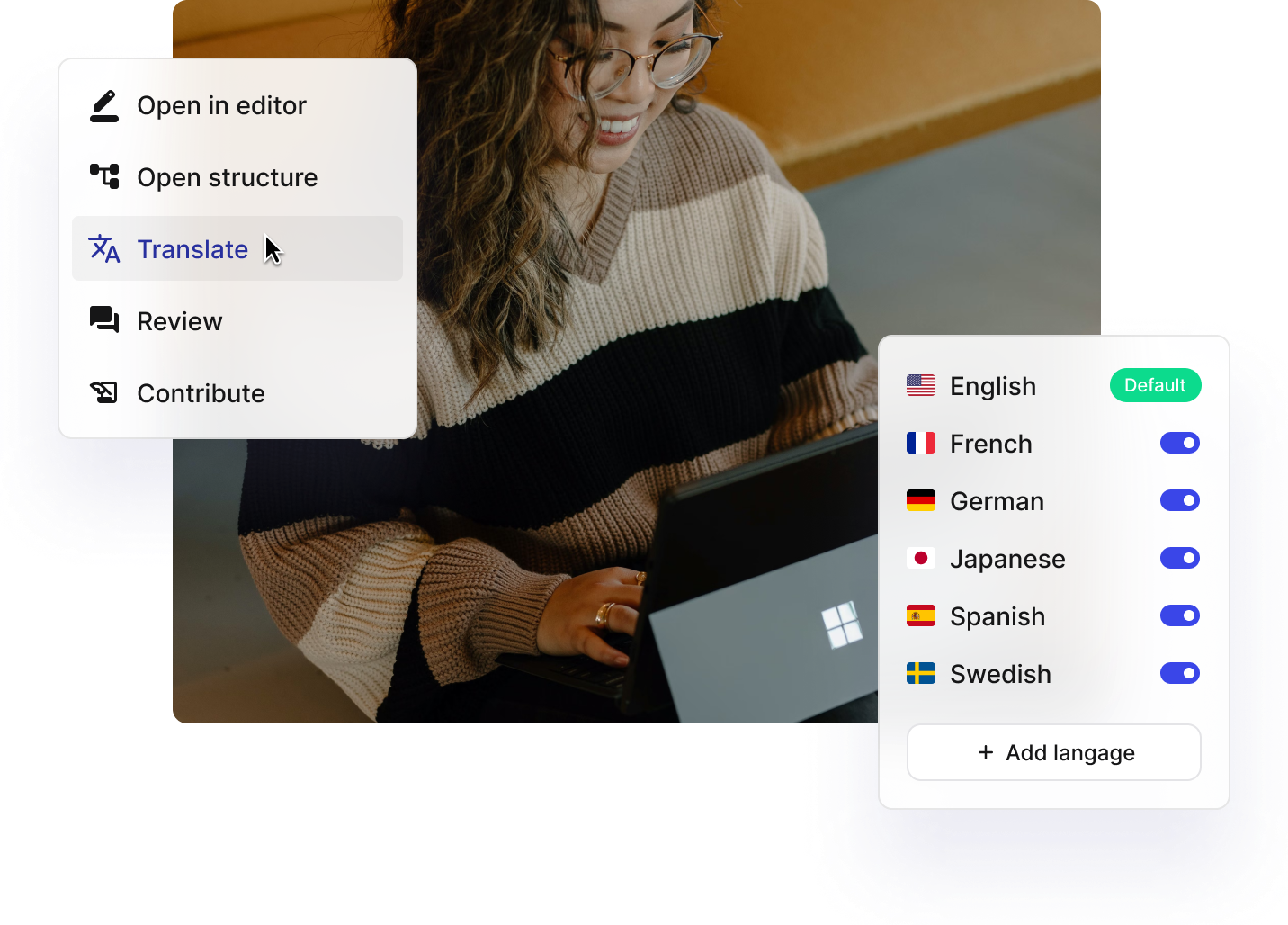- Home
- Blog
- Technical writing
- How Integrating a CCMS and a TMS Enables Scalable Multilingual Documentation
How Integrating a CCMS and a TMS Enables Scalable Multilingual Documentation

When you run a global business, you understand the need to provide content in multiple languages. Multilingual technical documentation is particularly crucial in regulated industries, such as pharmaceuticals, medical devices, and manufacturing. Accurate, timely, and compliant technical documentation is non-negotiable when it comes to using products safely and properly, not only for customer safety but also for legal compliance and maintaining a strong brand reputation.
However, the decision to provide your content in multiple languages is not as straightforward as simply writing your source content and asking someone to translate it into additional languages. You need a clear strategy for translation management, and you need the right technology.
In this blog, we’ll explore the need for multilingual technical documentation and the challenges associated with translating it. We’ll examine the creation of effective translation workflows and explore the value that a Translation Management System (TMS) brings to the process. Plus, we’ll tell you how Paligo CCMS integrates with three popular TMS platforms.
Ready to get started? Let’s go.
Bridging the Strategic Gap Between Technical Content and Translation
Phrase and Paligo present this webinar on how to align business processes with content management and localization processes.
The Unique Challenges of Translating Technical Documentation
Translation management is challenging for every type of business content, especially if you don’t have a clearly defined strategy and process. If you work with an ad hoc translation process, then you understand these challenges well:
- Tracking translations in a spreadsheet, emailing documents back and forth to multiple people to add translations, review and comment, make changes, resend for review, and eventually approve and publish.
- Version control is a nightmare – there’s no way to ensure the correct version of a document is being reviewed or edited.
- Deadlines are missed because there are no assigned tasks, notifications, or reporting.
Terminology is inconsistent across (and sometimes within) documents, and critical errors in instructions or legal disclaimers are often missed. - Content is translated inconsistently across publishing formats, including XML, PDF, in-app help, HTML, etc.
Apply these challenges to translating technical documentation such as manuals, guides, knowledge base articles, and instructions for use, and you’ll have even more concerns. Unlike marketing copy or business content, technical information has no room for error or ambiguity. Inaccurate technical instructions or safety warnings can lead to misusing a product or equipment, which could result in serious consequences.
Then, there’s the added challenge of consistently managing highly specific, often proprietary, technical terms across documentation and languages. This type of documentation can change frequently, sometimes involving small changes to update bug fixes or minor enhancements, and other times major updates that replace complete documentation or add significant sections.
Another aspect to consider is legal and compliance. Technical documentation must adhere to different regulations and legal standards in different countries or markets. This includes legal content in documentation such as warranties, regulatory statements, terms of use, and compliance declarations. It is critical to ensure this type of content is translated accurately and according to proper jurisdictions.
Translation management for technical documentation requires a clearly defined strategy, one that is best put in place when you are planning your documentation, not at the end after that documentation is already created. When you think about your multilingual requirements from the start, you will be better equipped to deal with the range of translation needs as they happen.
What is Translation Management?
Translation management is the process of taking content written in a source language and translating it into other languages and locales. Note the distinction between translation and localization.
- Translation: Translating text from one language to another, ensuring the meaning and purpose of the source content are accurate across languages.
- Localization: Ensuring translated content adheres to cultural, technical, and legal requirements of a location or market, including currency and date formats, product naming and standards, and legal terms.
When you frame translation management as a strategic business process, you develop a systematic process for planning, executing, tracking, and optimizing all the activities involved in producing multilingual content. This process ensures that your multilingual content is accurate, consistent, and compliant.
Some things you include in your process:
- Who’s involved and what are their roles and responsibilities: translators, reviewers, legal/compliance teams, and technical writers.
- Translation workflows that map the translation process as part of the content creation and editing process.
- The definition of controlled vocabularies and glossaries that ensure translated content is consistent and accurate across documentation.
- Structured content authoring for easier translation, including reusing translations across documentation.
Of course, the best translation management process also includes using technology, specifically a translation management system.
Understanding Translation Management Systems (TMS)
A translation management system (TMS) is typically a cloud-based SaaS platform that manages the end-to-end process of translating content for a company. A TMS streamlines the translation process, centralizing all the activities required to translate technical content. It provides both human and AI-powered translation, combining the best of both to deliver multilingual content quickly and accurately.
Some key capabilities of a TMS include:
- Translation projects, with progress tracking and reporting
- Workflows that manage the creation of translations and the review and approval of translations in the TMS before they are exported.
- Glossaries and terminology management provide guidelines for translators on the meaning and usage of key terms and phrases.
- Quality assurance and automated validation, including fixing typos, formatting, and terminology inconsistencies.
- Translation memory (TM) that stores previously translated content, which is used to reduce the amount of new translation required.
- Out-of-the-box integration with component content management systems (CCMS) and other content management systems.
A TMS provides a collaborative environment where companies have visibility into the translation process and can support translators when they have questions.
The best TMS systems reduce both the manual effort and costs associated with translation.
A Note on Translation Memory
Translation memory is especially important when translating large amounts of technical documentation. A database stores previously translated text segments, such as sentences, paragraphs, or headings, along with their corresponding source language texts. In the case of structured content, the TMS can store the components.
When new content needs translation, the TMS can compare the new source components against the ones stored in the TM and determine:
- A perfect match
- 100% match – The content matches the source, but the context differs. The translator needs to review the translation to determine if it is accurate for the new context.
- Fuzzy match – The content matches 99% or less. The translator must then edit the suggestion instead of translating from scratch.
Translation memory provides many benefits, including:
- Speeding up the translation process because translators don’t need to start from scratch every time or re-translate existing translated content.
- Ensuring the same content is translated identically across all projects and documentation.
- Helping to maintain the overall quality of translated content.
- Reducing the costs associated with translating content.
Paligo's LanguageWire Integration Explained
Discover the benefits for your team and your organization when integrating Paligo with LanguageWire.
TMS + CCMS: A Critical Integration for Technical Documentation
Let’s talk about integrating a Translation Management System and a Component Content Management System, with a particular focus on Paligo CCMS.
A CCMS creates and manages documentation following a structured content model. A structured content model means content is broken down into discrete topics or components that authors can reuse across documentation. This approach to content management is particularly well-suited for translation management, as a TMS can more easily track what content is new, what has changed, and what remains unchanged in each component. Plus, even though a component is used many times, it only needs to be translated once. The result is faster translations and significant cost savings.
Consider a situation where structured content is not used for technical documentation. Each document would be sent to a TMS for translation, even if multiple documents contain duplicate content. The content is translated multiple times, which poses a risk of inconsistencies in translations across documents.
Another reason structured content is better for translations is that it is translated before it is formatted. If you send a formatted Word or PDF document for translation, you will incur an additional charge for desktop publishing formatting (DTP) in addition to the actual translation. According to Sarah Keefe, CEO and founder of Scriptorium, DTP typically accounts for 30-50% of a total translation invoice, so removing it would significantly reduce translation costs.
The CCMS also remains the master repository for all language versions of the content, ensuring consistency and control, and it handles the complexities of assembling and formatting multilingual publications from the approved translated components.

Paligo’s Built-in TMS Integrations
Paligo offers built-in integrations with several TMS, including Phrase, Crowdin, and LanguageWire. It also provides an API to support integration with other TMSs.
Integration with Phrase
Phrase TMS is directly integrated with Paligo’s translation management workflow, allowing content to be sent to and received from Phrase. In Paligo, you create a translation project that links to a Phrase template. When you have content ready to send to translation, set its stage to “In Translation” and then export the translation. The content is automatically packaged and sent directly to Phrase.
You must notify Phrase that the content has been sent, but everything else is done for you once the integration is set up. When translated, the content is directly imported back into Paligo as either matched and approved in Phrase and ready for final checks in Paligo or fully translated but requires review and approval in Paligo. Once the translation content is approved, its status is set to “Released,” marking it as ready for publication.
It’s also important to note that images, variables, and profiled filters require separate translation packages and handling.
Integration with LanguageWire and Crowdin
The LanguageWire and Crowdin translation management systems do not directly integrate with Paligo from Paligo’s platform. Instead, they integrate with Paligo within their platforms.
Crowdin provides a Paligo application that you download and connect to your Paligo instance. When you have content to translate, set the translation workflow stage to “In Translation” in Paligo and then navigate to the Crowdin app to sync the content. This imports the content to Crowdin for translation.
You can set up scheduled synchronizations and email notifications for the status of translations. The translated content is automatically pushed back into Paligo, and the translation state is set to “In Translation Review.” Once the review is completed, the workflow stage is set to “Released,” and the content is ready for publication.
LanguageWire is slightly different, connecting to Paligo via a secure API. You set your content to “In Translation” in Paligo, then go to your LanguageWire account and initiate the export of that content from Paligo. Once translated, the content is automatically imported into Paligo for review and approval.

The Benefits of Integrating Paligo CCMS and a TMS
There are many benefits for both the business and the technical documentation team when integrating a TMS with Paligo CCMS.
Business Benefits
For the business, the biggest benefit is reduced translation costs. By leveraging Translation Memory and AI-powered/generative AI translations, there is less content to translate, and translations happen much faster. A faster turnaround time helps businesses accelerate multilingual content delivery, which can help them move into new markets faster.
Using a TMS to manage all translations also helps to enhance brand consistency. Translation memory, along with the use of terminology banks and glossaries, ensures a consistent brand voice, terminology, and messaging across languages and target markets. It also ensures that content, such as instructions for use, is consistent across languages.
Finally, compliance and security are also key benefits when using a TMS. Content moves securely between the CCMS and the TMS, and they follow robust version control and audit trails to ensure the correct content is always being translated and published, regardless of what language it’s in.
Documentation Team Benefits
There are also many benefits for technical writers and content creators. First, a seamless workflow enables you to initiate, manage, and track the entire translation lifecycle directly within the Paligo CCMS environment as part of your regular content creation and update process.
Direct integrations eliminate errors associated with manual tasks, such as copying and pasting content between systems, and accelerate the translation process because content is only translated once, even if it is used in multiple publications within the CCMS.
A consistent brand voice and terminology are also important for technical writers. Using a TMS means they are confident that the translated content accurately matches the source language and is updated as the source content changes.
Translated content is managed alongside its source content in the Paligo CCMS, which means that version control and audit trails help ensure the accuracy and compliance of multilingual content.
Crowdin's Paligo Integration Explained
Discover the benefits for your team and your organization when integrating Paligo with Crowdin.
Best Practices for Effective Translation Management
Let’s wrap up our look at translation management with some best practices.
Think Globally from the Start
Integrate translation planning into the content lifecycle, not as an afterthought. Some companies add translation management after the fact. They assume any process they design to create and manage content will work fine for translations. However, writing content with translation in mind can dramatically alter how you think about your content workflow.
Even if you aren’t ready to publish translated content, you should design your content development strategy with multilingual content in mind. Identify the markets and languages you want to include and map out any key requirements that could affect how you write your content.
Key considerations include your structured content model and how you manage images and text strings. Think about your content reuse strategy to understand where you can reduce translation costs. Also, think about how to best incorporate translation review into your content management process so that translated content is quickly reviewed and approved for publishing.
Build Translation into the Content Workflow
A simple yet effective content workflow will have translation built in. Content workflows provide accountability and transparency and reduce errors and bottlenecks. A workflow with translation built-in might look like this:
- Stage 1: Content preparation (component-level, structured), reviewed and approved in the source language.
- Stage 2 (In translation): Language assignment and automated handoff to TMS.
- Stage 3 (Translation Review): Translated content is imported back into the CCMS for translation and review
- Stage 4: Legal/compliance review (if required)
- Stage 5 (Released): Final approval and publishing.
Empower Translation Reviewers
Provide SMEs and legal reviewers with easy-to-use tools to review translated content, including reviewing translations in context. Establish clear guidelines on what to do if there are translation issues and regularly provide effective feedback.
Choose TMS Technology Wisely
Select a TMS that fits your needs and integrates seamlessly with your CCMS. You will need to understand your translation requirements and map those against the capabilities and limitations of the Translation Management Systems you are looking at.
Treat your selected TMS as a strategic partner. Regularly provide clear instructions, context, and feedback to keep everyone on the same page. Also, a clearly defined SLA (service level agreement) should be established so that everyone understands the expectations of the TMS provider, including translation turnaround times and how to manage issues that might arise.
Centralize and Govern Assets
Look for a TMS that maintains a single, high-quality TM, controlled vocabulary and terminology. Your documentation team must collaborate with the business units to create glossaries and terminology you want your TMS to use. Establish clear ownership and update processes of that terminology, and define the process for updating it in the TMS as required.
Measure Everything That Matters
Define Key Performance Indicators (KPIs) such as cost savings from TM leverage, turnaround time, first-pass quality rates, and reviewer turnaround time, and use these analytics to drive continuous improvement.
Prioritize Legal Diligence
Ensure legal review is a mandatory, tracked step for relevant content, especially documentation components that must adhere to compliance rules and specific market regulations. Leverage your CCMS translation workflow to record and maintain an audit trail of approvals.
Effective Translation Management is Essential for Technical Documentation Success in Global Markets
Effective translation management is non-negotiable for delivering accurate and compliant technical documentation in global markets. Success requires moving beyond ad hoc methods to a strategic approach involving clear workflows, structured content, and robust technology.
Integrating a Component Content Management System (CCMS), such as Paligo, with a Translation Management System (TMS) is crucial. Paligo’s integrations with leading TMS platforms such as Phrase, Crowdin, and Language Wire streamline the entire process, from automated handoffs to leveraging translation memory and terminology. This powerful combination significantly reduces costs and turnaround times, enhances quality and consistency, and ensures compliance.
Ultimately, you want a scalable foundation for managing multilingual technical content effectively. Let us know if you want to learn more about Paligo translation management processes.
Get started with Paligo
Paligo is built to meet the most demanding requirements, with plans made for any company from the growing SMB to the large Enterprise.
Share
Author

Barb Mosher Zinck
Barb Mosher Zinck is a senior content marketer and marketing technology analyst. She works with a range of clients in the tech market and actively tracks and writes about digital marketing, customer experience and enterprise content management. Barb understands the value of technology and works hard to inform and encourage greater understanding of its role in the enterprise




